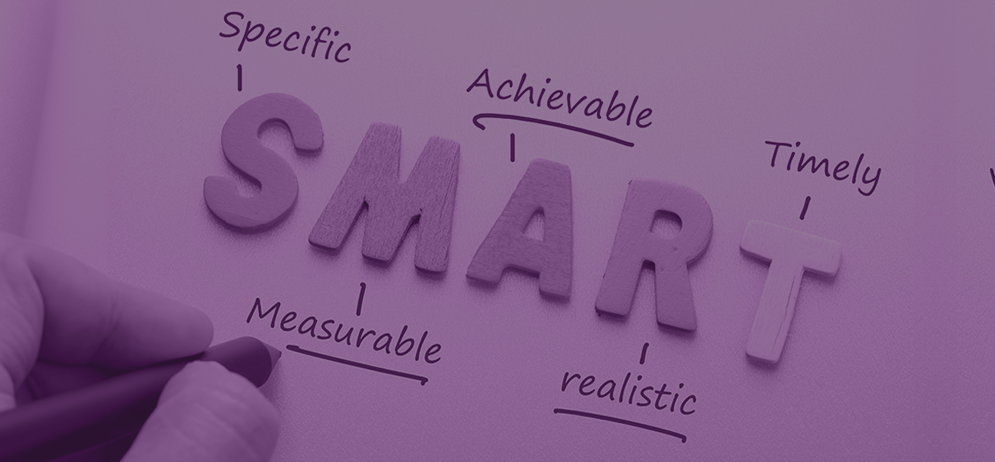As K-12 school districts around the country start the new school year, teachers are not only thinking about the goals they have for their students’ development, but also their own learning. This blog will explore how K-12 district leaders can support their teachers’ goal setting for the year, professional development best practices and how to use S.M.A.R.T. goals to nurture growth mindsets and a goal setting culture overall.
Before you send teachers into the goal setting process, it’s important to establish some foundations. What are the overall questions teachers should be seeking to respond to with their goals? These should be based on your school district’s values and larger goals, reporting on performance and feedback from prior teaching years, and also the personal vision of each teacher. For example: What are some important changes that I should make in my classroom or in my teaching practice this year? What school or classroom data can help guide my goal setting? What student needs – low achieving, high achieving, accommodations, special needs – should I consider when setting well-rounded goals? How will I adjust my goals to align with our districts evolving culture around growth mindsets?
What are S.M.A.R.T goals, and why is this goal setting structure important?
S.M.A.R.T stands for Specific, Measurable, Achievable, Relevant, Time-bound; these are the qualities you want to encourage teachers in your districts to prioritize when they are setting goals. For each goal they set, they’ll want to make sure these five qualities are present and specify how they are present.
Here’s how teachers can implement the S.M.A.R.T. strategy into their goals. They should consider each of the elements as essentially a part of the outline of an overall goal. Once a teacher has a response to each section, they will combine them all into a goal. If you have a goal in mind beforehand, it’s a good idea to literally write out why your goal is specific, measurable, etc. to make sure it aligns.
Here are helpful guidance questions and an example:
S: Specific/Strategic:
- What is the specific goal you are trying to achieve? Make sure your goal is very clear in the wording of your final goal and think about how it connects to larger goals within your team/school/district.
- Ex: I want to improve reading outcomes for my 3rd grade students over last year.
M: Measurable (Plan!)
- How will you measure progress and know the goal has been met?
- Ex: 30% of students moved up a reading level last year – I’d like to see at least 50% move up this year.
A: Achievable/Actionable
- How will you accomplish this goal? What necessary actions will you take?
- Ex: In a recent training, I learned some great techniques for learning retention around reading in this age group. I will work on a new skill every month, implementing those techniques. Additionally, we’ll build more reading games into the schedule alongside quiet reading and library time.
R: Relevant
- How do these goals apply to your overall responsibilities?
- Ex: Reading is a key skill to solidify for this age group, and a huge part of the learning students will be doing in my class. Additionally, the school has an overall goal to focus on reading skills this year, and I will be contributing to that goal by taking responsibility for my third-grade class.
T: Time-Bound
- When do you hope to achieve this?
- Ex: Every three months, we will re-evaluate the students and measure who is moving up and who may need more support. By checking in on this schedule, we should have a good idea at the end of the year how each student is doing and can evaluate the class as a whole.
Goal: This year, I will improve reading outcomes in my 3rd grade class by implementing new teaching techniques and checking in on progress on a monthly basis. By the end of the year, the goal is to have at least 50% of students move up a reading level and have all students leave the 3rd grade feeling confident in their reading abilities.
By thinking about all of these smaller aspects of a goal, it ensures teacher goals are achievable and rewarding, and strategically fit into a larger vision for their school, district and career. Teachers get into the habit of creating goals that encourage growth in them and their students and push them toward larger goals.
Remember to share these best practices as your teachers work on their goals:
- Personal and student focus: Respond to previous performance feedback as well as student data. Consider where additional support, training or data may help make goals achievable.
- Keep it simple and organized: Use the S.M.A.R.T goals model to outline your goals, and don’t shy away from stating the obvious.
- Go for it! Be ambitious with your goal setting; challenge yourself.
- Check in: Establish opportunities to check in on progress.
- Get feedback and collaborate when you can: Get feedback from someone who knows the context within which you’re working and can provide insights.
- Be clear: Make sure goals are clear about what will indicate success! You’ll want to be able to easily check the boxes as you work through the year, rather than have to wade through ambiguous language or unclear finish lines.
For a platform that will help your teachers prioritize PD and achieving their S.M.A.R.T. goals with feedback integrated, explore Frontline Professional Development! The software brings professional learning, collaboration and evaluations together, providing a virtual solution with personalized PD content and reporting while saving money (think a convenient online learning platform vs. a conference). This Pennsylvania case study outlines some of the practical benefits of Frontline Professional Development and the administrative transformation it can facilitate in your school districts – check it out!
